Struggling With Your B2B Paid Social Strategy? This Might Be Why
How you’ve been approaching B2B paid social is hurting your company’s growth and wasting your valuable budget.
Below you will find the following:
Why optimizing only for leads results in wasted time and low-quality leads
Why you need to adopt demand generation into your paid social strategy
How to create demand on LinkedIn and Facebook with paid ads
How to use 3rd party data solutions to target your ICP more effectively on key channels to save budget
How to measure the impact of paid social optimized for demand generation
If you’re reading this, you’ve probably given up (or are thinking about giving up) on paid social because you see the number of low-quality leads coming through and deem it an expensive and ineffective strategy.
The reality: you just haven’t been taught how to use paid social effectively.
After reading this article, we promise you’ll be re-energized and excited to make the most of paid social to help grow your company.
Let’s get to it!
Companies who understand that brand creates demand will always win
Think like a customer for a second.
You are a Marketing Director who needs a new CRM.
You visit a couple of websites and begin researching.
The next day, you hop on LinkedIn and see an ad from one of these CRMs (let’s call them company A) and they’re offering an in-depth eBook comparing the best CRMs today. You download the resource in exchange for your email because you find value in the piece.
Almost instantaneously, you receive an email, or worse, A CALL from a sales rep at the company asking if you want to set up a demo.
Are you happy? Probably not. You politely decline the demo invite.
The next day, you receive another email asking if you want a demo. And again the next day. And again and again…
On the flip side, you’ve been seeing another CRM company’s ads and organic content on social (let’s call them company B). The content is always educational, helpful, and insightful. You begin to develop a love for the brand because they provide value to you.
They never push hard for a demo and instead, build demand for their product through great content served in the right place at the right time.
When it comes time to choose a CRM, which of these two companies are you choosing?
Using paid social exclusively for leads hurts your brand and wastes your money
When you act like company A in the example above, your team will find paid social to be expensive and ineffective because you end up with low-quality leads that don’t convert. Worse, you leave a bad taste in people’s mouths about your brand.
When you act like company B, you create demand for your product. By the time a prospect reaches you, they are already warm to your brand and want to work with you.
You also end up improving business metrics that matter like:
Customer acquisition cost
Cost per lead
Sales pipeline value
Average deal size
Customer lifetime value
Time to close
Revenue generated against the overall budget
We’re not saying that lead gen is dead. We’re saying that lead gen without demand gen is a losing strategy. They need to coexist and the best B2B brands know it.
Let’s take a look at the consumer insights platform, Zappi which does a great job at executing a blended paid ads approach
Example #1: Demand Gen ad by promoting their podcast
How you’ve been approaching B2B paid social is hurting your company’s growth and wasting your valuable budget.
Below you will find the following:
Why optimizing only for leads results in wasted time and low-quality leads
Why you need to adopt demand generation into your paid social strategy
How to create demand on LinkedIn and Facebook with paid ads
How to use 3rd party data solutions to target your ICP more effectively on key channels to save budget
How to measure the impact of paid social optimized for demand generation
If you’re reading this, you’ve probably given up (or are thinking about giving up) on paid social because you see the number of low-quality leads coming through and deem it an expensive and ineffective strategy.
The reality: you just haven’t been taught how to use paid social effectively.
After reading this article, we promise you’ll be re-energized and excited to make the most of paid social to help grow your company.
Let’s get to it!
Companies who understand that brand creates demand will always win
Think like a customer for a second.
You are a Marketing Director who needs a new CRM.
You visit a couple of websites and begin researching.
The next day, you hop on LinkedIn and see an ad from one of these CRMs (let’s call them company A) and they’re offering an in-depth eBook comparing the best CRMs today. You download the resource in exchange for your email because you find value in the piece.
Almost instantaneously, you receive an email, or worse, A CALL from a sales rep at the company asking if you want to set up a demo.
Are you happy? Probably not. You politely decline the demo invite.
The next day, you receive another email asking if you want a demo. And again the next day. And again and again…
On the flip side, you’ve been seeing another CRM company’s ads and organic content on social (let’s call them company B). The content is always educational, helpful, and insightful. You begin to develop a love for the brand because they provide value to you.
They never push hard for a demo and instead, build demand for their product through great content served in the right place at the right time.
When it comes time to choose a CRM, which of these two companies are you choosing?
Using paid social exclusively for leads hurts your brand and wastes your money
When you act like company A in the example above, your team will find paid social to be expensive and ineffective because you end up with low-quality leads that don’t convert. Worse, you leave a bad taste in people’s mouths about your brand.
When you act like company B, you create demand for your product. By the time a prospect reaches you, they are already warm to your brand and want to work with you.
You also end up improving business metrics that matter like:
Customer acquisition cost
Cost per lead
Sales pipeline value
Average deal size
Customer lifetime value
Time to close
Revenue generated against the overall budget
We’re not saying that lead gen is dead. We’re saying that lead gen without demand gen is a losing strategy. They need to coexist and the best B2B brands know it.
Let’s take a look at the consumer insights platform, Zappi which does a great job at executing a blended paid ads approach
Example #1: Demand Gen ad by promoting their podcast
How you’ve been approaching B2B paid social is hurting your company’s growth and wasting your valuable budget.
Below you will find the following:
Why optimizing only for leads results in wasted time and low-quality leads
Why you need to adopt demand generation into your paid social strategy
How to create demand on LinkedIn and Facebook with paid ads
How to use 3rd party data solutions to target your ICP more effectively on key channels to save budget
How to measure the impact of paid social optimized for demand generation
If you’re reading this, you’ve probably given up (or are thinking about giving up) on paid social because you see the number of low-quality leads coming through and deem it an expensive and ineffective strategy.
The reality: you just haven’t been taught how to use paid social effectively.
After reading this article, we promise you’ll be re-energized and excited to make the most of paid social to help grow your company.
Let’s get to it!
Companies who understand that brand creates demand will always win
Think like a customer for a second.
You are a Marketing Director who needs a new CRM.
You visit a couple of websites and begin researching.
The next day, you hop on LinkedIn and see an ad from one of these CRMs (let’s call them company A) and they’re offering an in-depth eBook comparing the best CRMs today. You download the resource in exchange for your email because you find value in the piece.
Almost instantaneously, you receive an email, or worse, A CALL from a sales rep at the company asking if you want to set up a demo.
Are you happy? Probably not. You politely decline the demo invite.
The next day, you receive another email asking if you want a demo. And again the next day. And again and again…
On the flip side, you’ve been seeing another CRM company’s ads and organic content on social (let’s call them company B). The content is always educational, helpful, and insightful. You begin to develop a love for the brand because they provide value to you.
They never push hard for a demo and instead, build demand for their product through great content served in the right place at the right time.
When it comes time to choose a CRM, which of these two companies are you choosing?
Using paid social exclusively for leads hurts your brand and wastes your money
When you act like company A in the example above, your team will find paid social to be expensive and ineffective because you end up with low-quality leads that don’t convert. Worse, you leave a bad taste in people’s mouths about your brand.
When you act like company B, you create demand for your product. By the time a prospect reaches you, they are already warm to your brand and want to work with you.
You also end up improving business metrics that matter like:
Customer acquisition cost
Cost per lead
Sales pipeline value
Average deal size
Customer lifetime value
Time to close
Revenue generated against the overall budget
We’re not saying that lead gen is dead. We’re saying that lead gen without demand gen is a losing strategy. They need to coexist and the best B2B brands know it.
Let’s take a look at the consumer insights platform, Zappi which does a great job at executing a blended paid ads approach
Example #1: Demand Gen ad by promoting their podcast




The majority of B2B brands NEVER use paid social for anything other than lead generation. Here, Zappi is focusing on brand, education, and nurturing by sending a prospect to their podcast where they know they serve valuable information for their ICP.
It won’t result in an immediate lead, but it plays the long game so when a person is ready to buy, they remember content like this and will choose their brand.
Example #2: Lead gen ad that promotes a case study that solves a customer pain point
The majority of B2B brands NEVER use paid social for anything other than lead generation. Here, Zappi is focusing on brand, education, and nurturing by sending a prospect to their podcast where they know they serve valuable information for their ICP.
It won’t result in an immediate lead, but it plays the long game so when a person is ready to buy, they remember content like this and will choose their brand.
Example #2: Lead gen ad that promotes a case study that solves a customer pain point
The majority of B2B brands NEVER use paid social for anything other than lead generation. Here, Zappi is focusing on brand, education, and nurturing by sending a prospect to their podcast where they know they serve valuable information for their ICP.
It won’t result in an immediate lead, but it plays the long game so when a person is ready to buy, they remember content like this and will choose their brand.
Example #2: Lead gen ad that promotes a case study that solves a customer pain point




What this ad does well:
Using big brands as case studies to create social proof for prospects (Mcdonald’s and Cheetos)
Simple but effective copy that shows the outcome brands get by working with Zappi (the ability to quickly optimize creations to get ideas in front of consumers early)
With this blended approach to paid social, Zappi is not only creating demand but is giving itself the opportunity to create a predictable pipeline that will grow its business for a long time to come.
Sounds nice, doesn’t it?
Demand generation and demand capture are key to a successful paid social strategy
Before we dive into examples of how to create demand via paid social on LinkedIn and Facebook (Meta), let’s quickly visualize today’s B2B sales funnel that combines demand generation and demand capture.
What this ad does well:
Using big brands as case studies to create social proof for prospects (Mcdonald’s and Cheetos)
Simple but effective copy that shows the outcome brands get by working with Zappi (the ability to quickly optimize creations to get ideas in front of consumers early)
With this blended approach to paid social, Zappi is not only creating demand but is giving itself the opportunity to create a predictable pipeline that will grow its business for a long time to come.
Sounds nice, doesn’t it?
Demand generation and demand capture are key to a successful paid social strategy
Before we dive into examples of how to create demand via paid social on LinkedIn and Facebook (Meta), let’s quickly visualize today’s B2B sales funnel that combines demand generation and demand capture.
What this ad does well:
Using big brands as case studies to create social proof for prospects (Mcdonald’s and Cheetos)
Simple but effective copy that shows the outcome brands get by working with Zappi (the ability to quickly optimize creations to get ideas in front of consumers early)
With this blended approach to paid social, Zappi is not only creating demand but is giving itself the opportunity to create a predictable pipeline that will grow its business for a long time to come.
Sounds nice, doesn’t it?
Demand generation and demand capture are key to a successful paid social strategy
Before we dive into examples of how to create demand via paid social on LinkedIn and Facebook (Meta), let’s quickly visualize today’s B2B sales funnel that combines demand generation and demand capture.




What this ad does well:
Using big brands as case studies to create social proof for prospects (Mcdonald’s and Cheetos)
Simple but effective copy that shows the outcome brands get by working with Zappi (the ability to quickly optimize creations to get ideas in front of consumers early)
With this blended approach to paid social, Zappi is not only creating demand but is giving itself the opportunity to create a predictable pipeline that will grow its business for a long time to come.
Sounds nice, doesn’t it?
Demand generation and demand capture are key to a successful paid social strategy
Before we dive into examples of how to create demand via paid social on LinkedIn and Facebook (Meta), let’s quickly visualize today’s B2B sales funnel that combines demand generation and demand capture.
What this ad does well:
Using big brands as case studies to create social proof for prospects (Mcdonald’s and Cheetos)
Simple but effective copy that shows the outcome brands get by working with Zappi (the ability to quickly optimize creations to get ideas in front of consumers early)
With this blended approach to paid social, Zappi is not only creating demand but is giving itself the opportunity to create a predictable pipeline that will grow its business for a long time to come.
Sounds nice, doesn’t it?
Demand generation and demand capture are key to a successful paid social strategy
Before we dive into examples of how to create demand via paid social on LinkedIn and Facebook (Meta), let’s quickly visualize today’s B2B sales funnel that combines demand generation and demand capture.
What this ad does well:
Using big brands as case studies to create social proof for prospects (Mcdonald’s and Cheetos)
Simple but effective copy that shows the outcome brands get by working with Zappi (the ability to quickly optimize creations to get ideas in front of consumers early)
With this blended approach to paid social, Zappi is not only creating demand but is giving itself the opportunity to create a predictable pipeline that will grow its business for a long time to come.
Sounds nice, doesn’t it?
Demand generation and demand capture are key to a successful paid social strategy
Before we dive into examples of how to create demand via paid social on LinkedIn and Facebook (Meta), let’s quickly visualize today’s B2B sales funnel that combines demand generation and demand capture.




Understanding how each effort differs and how they should be used together will make executing an impactful paid social strategy 10x easier.
What is demand generation?
Demand generation is any marketing and sales activity designed to create awareness and interest in your product throughout the customer journey from prospect to paying customer.
Gong does a great job of this in their paid social strategy by promoting podcast episodes that will be of value to their ICP which is sales professionals.
Understanding how each effort differs and how they should be used together will make executing an impactful paid social strategy 10x easier.
What is demand generation?
Demand generation is any marketing and sales activity designed to create awareness and interest in your product throughout the customer journey from prospect to paying customer.
Gong does a great job of this in their paid social strategy by promoting podcast episodes that will be of value to their ICP which is sales professionals.
Understanding how each effort differs and how they should be used together will make executing an impactful paid social strategy 10x easier.
What is demand generation?
Demand generation is any marketing and sales activity designed to create awareness and interest in your product throughout the customer journey from prospect to paying customer.
Gong does a great job of this in their paid social strategy by promoting podcast episodes that will be of value to their ICP which is sales professionals.
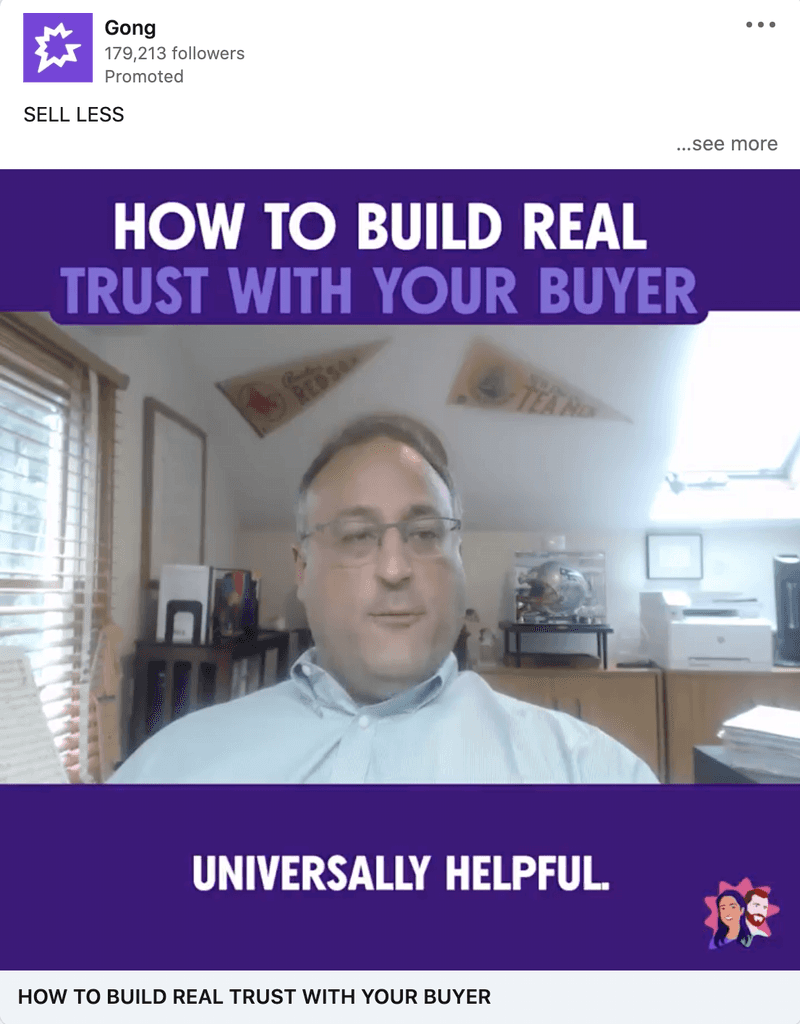



The goal of the ad isn’t to get an immediate lead but rather to build brand trust and demand for its product by giving away valuable information.
This approach to paid ads compounds overtime and when their ICP is ready to make a purchase, they are already top of mind making the conversion 10x easier than it otherwise would be with the traditional lead gen approach to paid social.
Successful demand gen is not about optimizing for bulk lead generation but rather serving content in the right place at the right time and with the right intent so what you’re sharing resonates with your ideal customer.
Demand gen done right, as we mentioned earlier, will allow your company to create a predictable and profitable pipeline that will grow your business for years to come.
The goal of the ad isn’t to get an immediate lead but rather to build brand trust and demand for its product by giving away valuable information.
This approach to paid ads compounds overtime and when their ICP is ready to make a purchase, they are already top of mind making the conversion 10x easier than it otherwise would be with the traditional lead gen approach to paid social.
Successful demand gen is not about optimizing for bulk lead generation but rather serving content in the right place at the right time and with the right intent so what you’re sharing resonates with your ideal customer.
Demand gen done right, as we mentioned earlier, will allow your company to create a predictable and profitable pipeline that will grow your business for years to come.
The goal of the ad isn’t to get an immediate lead but rather to build brand trust and demand for its product by giving away valuable information.
This approach to paid ads compounds overtime and when their ICP is ready to make a purchase, they are already top of mind making the conversion 10x easier than it otherwise would be with the traditional lead gen approach to paid social.
Successful demand gen is not about optimizing for bulk lead generation but rather serving content in the right place at the right time and with the right intent so what you’re sharing resonates with your ideal customer.
Demand gen done right, as we mentioned earlier, will allow your company to create a predictable and profitable pipeline that will grow your business for years to come.
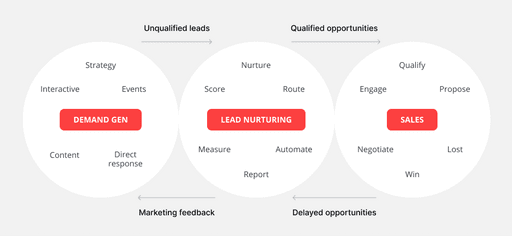



What is demand capture?
Demand capture, which can be thought of as lead capture, happens synonymously with demand gen.
At this stage, you capture your already warm prospect to purchase your product.
Here are a few ways to capture demand:
Product demos
Free trials
eBooks
Product comparison and spec sheets
Case Studies
Free consultations
You likely already take part in these marketing activities as a way to generate and capture leads.
There are plenty of companies that do a great job of capturing demand.
For example, Buzzsumo captures demand with an elite free trial experience driven by product-focused and educational email marketing.
First, Buzzsumo uses paid social to encourage users to sign up for a 30-day free trial where they are given full access to all the platform's powerful features.
Below are a couple of examples of the ads Buzzsumo serves to its target demographic to encourage free trial sign-ups.
What is demand capture?
Demand capture, which can be thought of as lead capture, happens synonymously with demand gen.
At this stage, you capture your already warm prospect to purchase your product.
Here are a few ways to capture demand:
Product demos
Free trials
eBooks
Product comparison and spec sheets
Case Studies
Free consultations
You likely already take part in these marketing activities as a way to generate and capture leads.
There are plenty of companies that do a great job of capturing demand.
For example, Buzzsumo captures demand with an elite free trial experience driven by product-focused and educational email marketing.
First, Buzzsumo uses paid social to encourage users to sign up for a 30-day free trial where they are given full access to all the platform's powerful features.
Below are a couple of examples of the ads Buzzsumo serves to its target demographic to encourage free trial sign-ups.
What is demand capture?
Demand capture, which can be thought of as lead capture, happens synonymously with demand gen.
At this stage, you capture your already warm prospect to purchase your product.
Here are a few ways to capture demand:
Product demos
Free trials
eBooks
Product comparison and spec sheets
Case Studies
Free consultations
You likely already take part in these marketing activities as a way to generate and capture leads.
There are plenty of companies that do a great job of capturing demand.
For example, Buzzsumo captures demand with an elite free trial experience driven by product-focused and educational email marketing.
First, Buzzsumo uses paid social to encourage users to sign up for a 30-day free trial where they are given full access to all the platform's powerful features.
Below are a couple of examples of the ads Buzzsumo serves to its target demographic to encourage free trial sign-ups.




Notice the tie-in to popular culture? They relate to both F1 fans and tennis fans by mentioning Max Verstappen and Serena Williams. If your ads are generic and lifeless, think of ways to include
Once someone has signed up for the free trial, Buzzsumo gets to work on building demand for the product via email marketing.
Buzzsumo sends out regular emails over the next 30 days to show users how to use the platform to achieve their content marketing goals by highlighting the many features of the platform itself.
For example, this is an example of a trial period email you will receive from Buzzsumo showing how to use their “Content Analyzer”. Notice how they are not only building demand by encouraging customers to use the feature itself but are also including reviews to build trust and credibility.
Notice the tie-in to popular culture? They relate to both F1 fans and tennis fans by mentioning Max Verstappen and Serena Williams. If your ads are generic and lifeless, think of ways to include
Once someone has signed up for the free trial, Buzzsumo gets to work on building demand for the product via email marketing.
Buzzsumo sends out regular emails over the next 30 days to show users how to use the platform to achieve their content marketing goals by highlighting the many features of the platform itself.
For example, this is an example of a trial period email you will receive from Buzzsumo showing how to use their “Content Analyzer”. Notice how they are not only building demand by encouraging customers to use the feature itself but are also including reviews to build trust and credibility.
Notice the tie-in to popular culture? They relate to both F1 fans and tennis fans by mentioning Max Verstappen and Serena Williams. If your ads are generic and lifeless, think of ways to include
Once someone has signed up for the free trial, Buzzsumo gets to work on building demand for the product via email marketing.
Buzzsumo sends out regular emails over the next 30 days to show users how to use the platform to achieve their content marketing goals by highlighting the many features of the platform itself.
For example, this is an example of a trial period email you will receive from Buzzsumo showing how to use their “Content Analyzer”. Notice how they are not only building demand by encouraging customers to use the feature itself but are also including reviews to build trust and credibility.
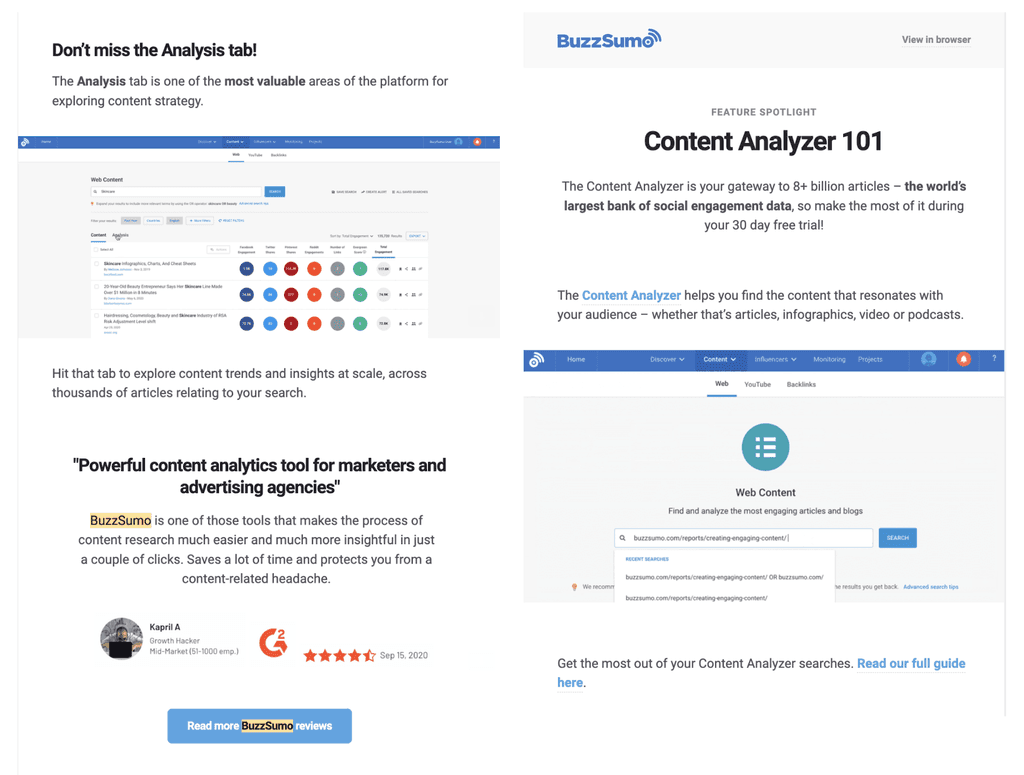



The key takeaway here is to choose a demand gen strategy that works for your company and double down on it. In Buzzsumo’s case, that is free trial signups and providing value and education via email drip campaigns to create trial conversions.
Now, let’s have a look at how to create demand via paid social on two key channels used by the majority of B2B companies: LinkedIn and Facebook.
How to create demand on LinkedIn via paid ads
Think of yourself as an everyday LinkedIn user. Are you intending to go onto the platform to be served ads and purchase a product? Unlikely.
So why do you hop on LinkedIn?
It’s likely for any of the following reasons:
To learn something new that helps you in your day-to-day life
To add like-minded people to your network
To take a break from work and entertain yourself
To consume content that will inspire you when you’re feeling down
What is the likelihood you would even pay attention to an ad that was pushing a product on LinkedIn? Probably pretty slim.
I think you get the point.
The best companies create demand on LinkedIn via paid social by using the platform as it was intended: To connect. To engage. To Inspire. To Educate.
Let’s take a look at Revalize and how they were able to increase account engagements by 50% by executing an impactful demand gen strategy via paid ads.
Example #1: Use a video carousel on LinkedIn to visually tell someone how to improve their quoting process
Keys to success with this type of ad:
Keep the text to a minimum on each slide and only include information that matters the most
Focus on pain-point copywriting that will trigger your prospect emotionally to show them that they need to change their way of thinking or miss out on doing things better
The key takeaway here is to choose a demand gen strategy that works for your company and double down on it. In Buzzsumo’s case, that is free trial signups and providing value and education via email drip campaigns to create trial conversions.
Now, let’s have a look at how to create demand via paid social on two key channels used by the majority of B2B companies: LinkedIn and Facebook.
How to create demand on LinkedIn via paid ads
Think of yourself as an everyday LinkedIn user. Are you intending to go onto the platform to be served ads and purchase a product? Unlikely.
So why do you hop on LinkedIn?
It’s likely for any of the following reasons:
To learn something new that helps you in your day-to-day life
To add like-minded people to your network
To take a break from work and entertain yourself
To consume content that will inspire you when you’re feeling down
What is the likelihood you would even pay attention to an ad that was pushing a product on LinkedIn? Probably pretty slim.
I think you get the point.
The best companies create demand on LinkedIn via paid social by using the platform as it was intended: To connect. To engage. To Inspire. To Educate.
Let’s take a look at Revalize and how they were able to increase account engagements by 50% by executing an impactful demand gen strategy via paid ads.
Example #1: Use a video carousel on LinkedIn to visually tell someone how to improve their quoting process
Keys to success with this type of ad:
Keep the text to a minimum on each slide and only include information that matters the most
Focus on pain-point copywriting that will trigger your prospect emotionally to show them that they need to change their way of thinking or miss out on doing things better
The key takeaway here is to choose a demand gen strategy that works for your company and double down on it. In Buzzsumo’s case, that is free trial signups and providing value and education via email drip campaigns to create trial conversions.
Now, let’s have a look at how to create demand via paid social on two key channels used by the majority of B2B companies: LinkedIn and Facebook.
How to create demand on LinkedIn via paid ads
Think of yourself as an everyday LinkedIn user. Are you intending to go onto the platform to be served ads and purchase a product? Unlikely.
So why do you hop on LinkedIn?
It’s likely for any of the following reasons:
To learn something new that helps you in your day-to-day life
To add like-minded people to your network
To take a break from work and entertain yourself
To consume content that will inspire you when you’re feeling down
What is the likelihood you would even pay attention to an ad that was pushing a product on LinkedIn? Probably pretty slim.
I think you get the point.
The best companies create demand on LinkedIn via paid social by using the platform as it was intended: To connect. To engage. To Inspire. To Educate.
Let’s take a look at Revalize and how they were able to increase account engagements by 50% by executing an impactful demand gen strategy via paid ads.
Example #1: Use a video carousel on LinkedIn to visually tell someone how to improve their quoting process
Keys to success with this type of ad:
Keep the text to a minimum on each slide and only include information that matters the most
Focus on pain-point copywriting that will trigger your prospect emotionally to show them that they need to change their way of thinking or miss out on doing things better
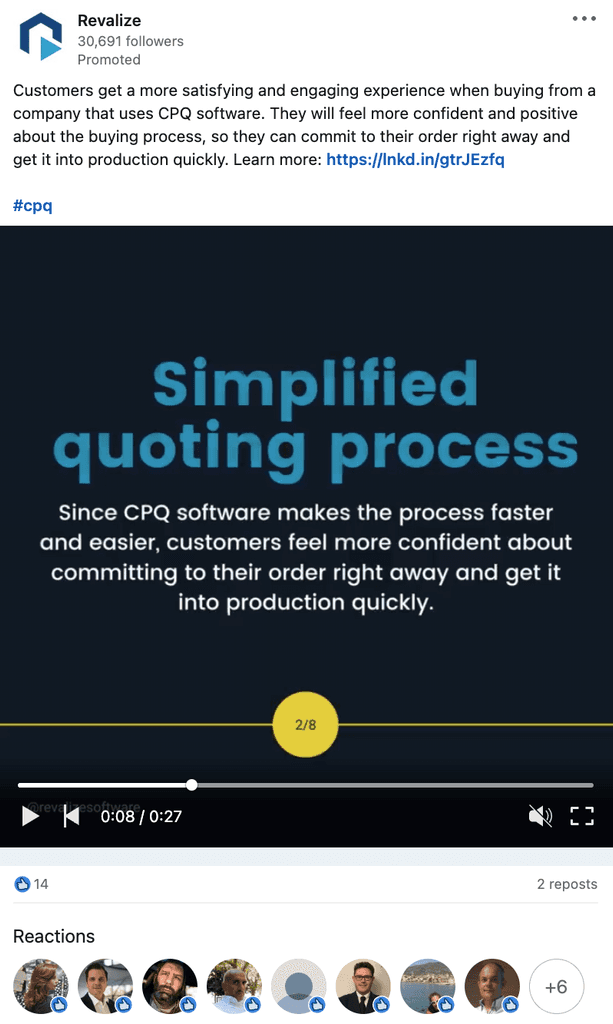



Example #2: Promote a value-driven blog post
Generating demand is all about providing value.
Blog posts like the one seen below are great for generating demand for a few reasons:
They provide information that educates your prospect and shows them a better way of doing things
It’s not pushy in terms of getting a sale
It builds trust and credibility making the decision to buy easier when your prospect is ready
Example #2: Promote a value-driven blog post
Generating demand is all about providing value.
Blog posts like the one seen below are great for generating demand for a few reasons:
They provide information that educates your prospect and shows them a better way of doing things
It’s not pushy in terms of getting a sale
It builds trust and credibility making the decision to buy easier when your prospect is ready
Example #2: Promote a value-driven blog post
Generating demand is all about providing value.
Blog posts like the one seen below are great for generating demand for a few reasons:
They provide information that educates your prospect and shows them a better way of doing things
It’s not pushy in terms of getting a sale
It builds trust and credibility making the decision to buy easier when your prospect is ready
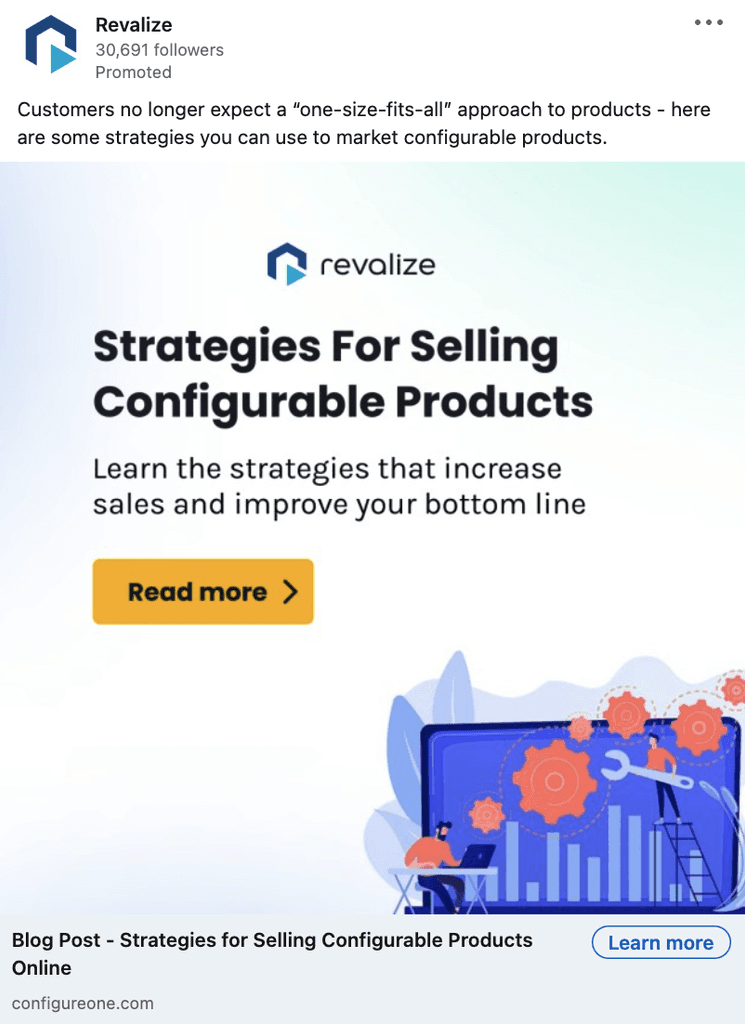



Example #3: Educate prospects on a framework that they don’t fully understand
Like the previous examples, this type of ad builds trust and credibility.
The idea here is that your prospect likely has heard of CPQ but doesn’t know enough about it to make an educated decision.
By providing a simple and digestible resource, you become a thought leader in their eyes. As long as the content on the other side of the ad is good, you will earn their attention and be top of mind when they are ready to buy.
Example #3: Educate prospects on a framework that they don’t fully understand
Like the previous examples, this type of ad builds trust and credibility.
The idea here is that your prospect likely has heard of CPQ but doesn’t know enough about it to make an educated decision.
By providing a simple and digestible resource, you become a thought leader in their eyes. As long as the content on the other side of the ad is good, you will earn their attention and be top of mind when they are ready to buy.
Example #3: Educate prospects on a framework that they don’t fully understand
Like the previous examples, this type of ad builds trust and credibility.
The idea here is that your prospect likely has heard of CPQ but doesn’t know enough about it to make an educated decision.
By providing a simple and digestible resource, you become a thought leader in their eyes. As long as the content on the other side of the ad is good, you will earn their attention and be top of mind when they are ready to buy.
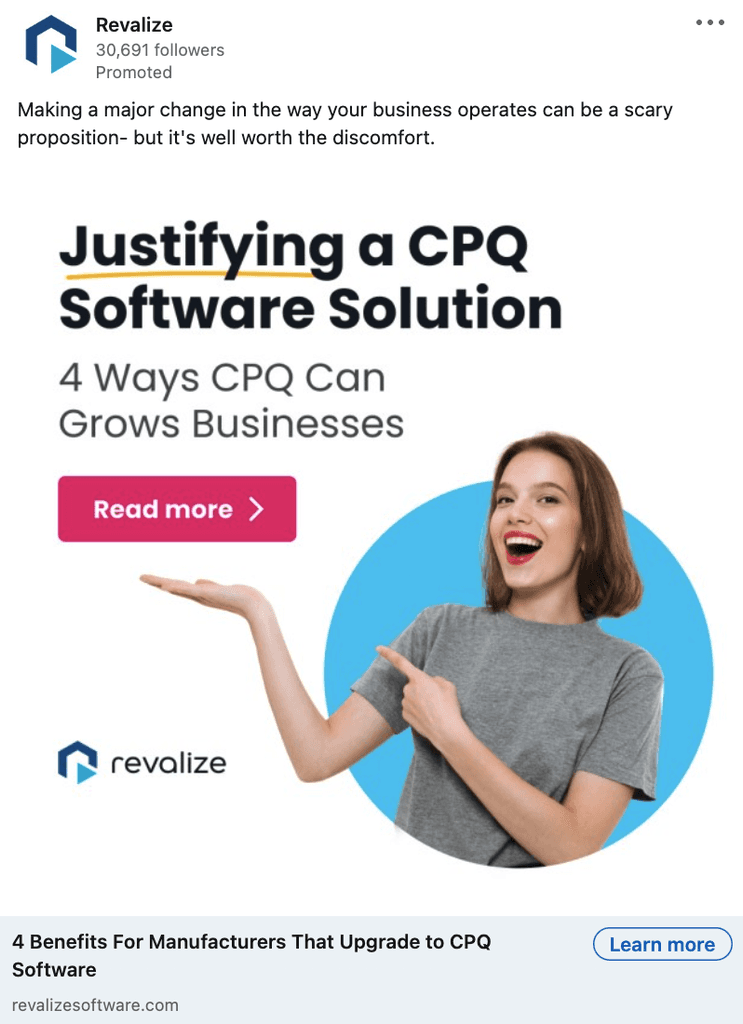



These ads have resulted in:
492 prospects reached
100 engagements
Over $100K in pipeline
How to create demand on Facebook via paid ads
Just like LinkedIn, the key here is to imagine yourself as an everyday Facebook user.
Why do you use Facebook?
Check-in on private Facebook groups
Find articles that interest you
Watch entertaining videos to pass the time
Due diligence for a brand that you love or are thinking of working with
Educational material that helps you in your day-to-day life
It’s highly unlikely you think to yourself, “I’m going to hop on Facebook to see if any good ads come up so I can buy something.”
So why would you serve ads to customers that simply aren’t ready to buy or even aware of what exactly it is you sell?
The goal should be to create awareness, position your brand as an industry leader, and educate your ideal customer on ways they can do their job better as it relates to the product or service you sell.
Cognism does a great job at this by regularly serving ads that cover the pain points of their ICP and then leading them to a helpful resource like a blog.
In the example below, that pain point is cold calling (something any sales professional can relate to and is always looking to get better at)
These ads have resulted in:
492 prospects reached
100 engagements
Over $100K in pipeline
How to create demand on Facebook via paid ads
Just like LinkedIn, the key here is to imagine yourself as an everyday Facebook user.
Why do you use Facebook?
Check-in on private Facebook groups
Find articles that interest you
Watch entertaining videos to pass the time
Due diligence for a brand that you love or are thinking of working with
Educational material that helps you in your day-to-day life
It’s highly unlikely you think to yourself, “I’m going to hop on Facebook to see if any good ads come up so I can buy something.”
So why would you serve ads to customers that simply aren’t ready to buy or even aware of what exactly it is you sell?
The goal should be to create awareness, position your brand as an industry leader, and educate your ideal customer on ways they can do their job better as it relates to the product or service you sell.
Cognism does a great job at this by regularly serving ads that cover the pain points of their ICP and then leading them to a helpful resource like a blog.
In the example below, that pain point is cold calling (something any sales professional can relate to and is always looking to get better at)
These ads have resulted in:
492 prospects reached
100 engagements
Over $100K in pipeline
How to create demand on Facebook via paid ads
Just like LinkedIn, the key here is to imagine yourself as an everyday Facebook user.
Why do you use Facebook?
Check-in on private Facebook groups
Find articles that interest you
Watch entertaining videos to pass the time
Due diligence for a brand that you love or are thinking of working with
Educational material that helps you in your day-to-day life
It’s highly unlikely you think to yourself, “I’m going to hop on Facebook to see if any good ads come up so I can buy something.”
So why would you serve ads to customers that simply aren’t ready to buy or even aware of what exactly it is you sell?
The goal should be to create awareness, position your brand as an industry leader, and educate your ideal customer on ways they can do their job better as it relates to the product or service you sell.
Cognism does a great job at this by regularly serving ads that cover the pain points of their ICP and then leading them to a helpful resource like a blog.
In the example below, that pain point is cold calling (something any sales professional can relate to and is always looking to get better at)




From here, they push their audience to a blog on their website that goes into detail about how to get better at cold calling and get their “mojo” back.
From here, they push their audience to a blog on their website that goes into detail about how to get better at cold calling and get their “mojo” back.
From here, they push their audience to a blog on their website that goes into detail about how to get better at cold calling and get their “mojo” back.
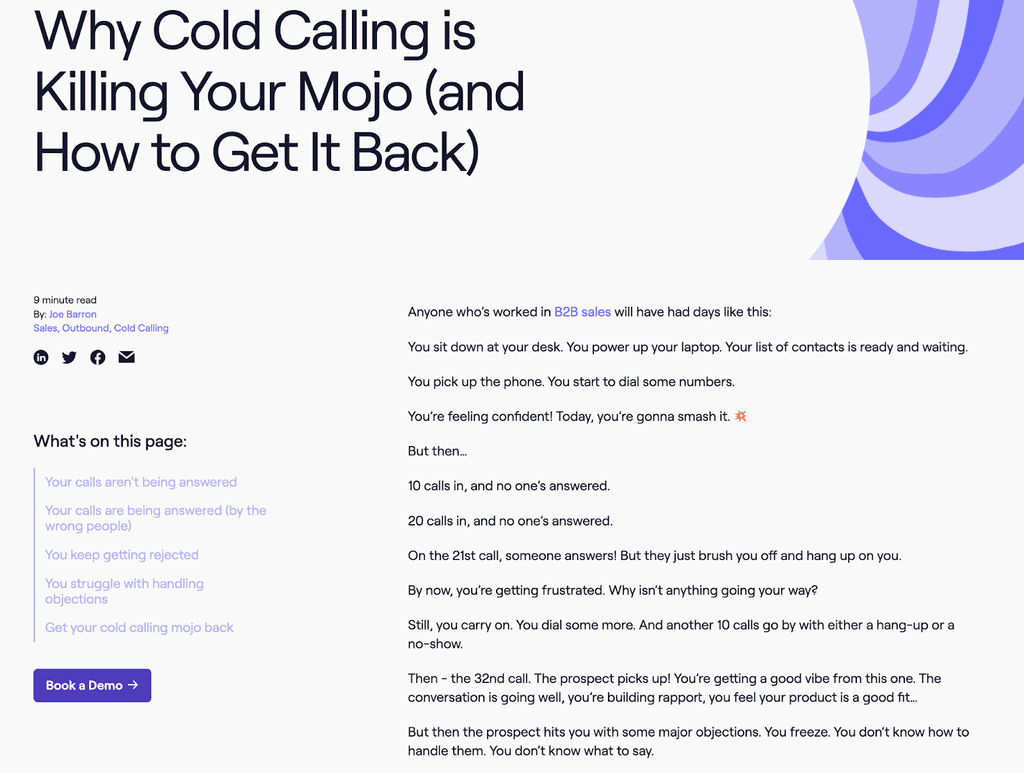



Creating demand via paid social doesn’t stop at the awareness stage, however. It is critical to effectively retarget your prospects to keep them engaged and continue to build trust.
Retargeting is the key to moving interested prospects through the buying journey to becoming customers
Retargeting will allow you to personalize your prospect's experience with your brand and as a result, build trust and create demand after first touches.
The key with retargeting is to segment customer behavior to identify where they are in their buying journey so that you can personalize their experience with your brand via paid social rather than serving everyone the same ads.
For example, retargeting everyone from the home page with a top-of-funnel eBook will not be effective for those who are near the conversion stage of their buying journey.
Instead, you want to retarget based on key indicators like:
Specific URL paths
Time on site (Facebook/LinkedIn)
Visits to the pricing page on the website
Let’s say a group of people have visited the pricing page but didn’t convert. From there, you know they are interested but not convinced the product is right for them.
When you retarget them, you need to serve ads that built trust and credibility to sway their decision to work with your brand.
Testimonials
Case studies
Comparison blogs
Product features in the media
How-to guides that solve your ICPs problems
Organic posts that did well among your ICP
All of the above are on the table and will help to build demand for your product after someone has visited the pricing page.
One problem is building an accurate ICP contact list can be difficult and costly so let’s talk about a great third-party data option to get there quicker and save money while you’re at it.
Leveraging 3rd party data sources can help you target your ICP more effectively (and save money)
Let’s start by saying the targeting options on Facebook and LinkedIn vary. While you can have a ton of success using Linkedin’s built-in targeting parameters - this is not the case with Facebook.
So how do you make Facebook work beyond simply retargeting audiences?
Enter 3rd party data providers like Zoominfo, Apollo, or Uplead.
In a nutshell, these tools will allow you to create a company contact list that accurately targets your ideal customer. From there, you can upload these lists to LinkedIn and Facebook respectively and begin to serve relevant content.
The result for you is money saved on testing targeting parameters while also improving conversions.
Speaking of improving conversions, it is important to know which metrics to track when evaluating your paid social demand gen strategy.
Measuring paid social requires you to re-define what metrics actually matter
The key performance indicators (KPIs) you deem important will determine whether or not you think something is working. Most B2B companies pay attention to the wrong metrics and as a result, look at marketing efforts like paid social as ineffective.
Rather than continuing to optimize paid social for MQLS, SQLs and other bulk lead strategies that yield poor results, you need to look at how your paid social efforts to impact the business holistically.
After all, understanding and prioritizing demand generation metrics will look a lot different from the metrics you’ve been told are important.
Here are the KPIs that provide the most insight into whether your paid social efforts are helping achieve business goals:
Cost Per Acquisition
Cost per acquisition reflects how much it costs for your company to acquire one new customer. You are likely familiar with cost per lead and how to calculate that. Cost per acquisition is the same except you divide the total media spend by the number of new customers acquired from the campaign you are running.
Creating demand via paid social doesn’t stop at the awareness stage, however. It is critical to effectively retarget your prospects to keep them engaged and continue to build trust.
Retargeting is the key to moving interested prospects through the buying journey to becoming customers
Retargeting will allow you to personalize your prospect's experience with your brand and as a result, build trust and create demand after first touches.
The key with retargeting is to segment customer behavior to identify where they are in their buying journey so that you can personalize their experience with your brand via paid social rather than serving everyone the same ads.
For example, retargeting everyone from the home page with a top-of-funnel eBook will not be effective for those who are near the conversion stage of their buying journey.
Instead, you want to retarget based on key indicators like:
Specific URL paths
Time on site (Facebook/LinkedIn)
Visits to the pricing page on the website
Let’s say a group of people have visited the pricing page but didn’t convert. From there, you know they are interested but not convinced the product is right for them.
When you retarget them, you need to serve ads that built trust and credibility to sway their decision to work with your brand.
Testimonials
Case studies
Comparison blogs
Product features in the media
How-to guides that solve your ICPs problems
Organic posts that did well among your ICP
All of the above are on the table and will help to build demand for your product after someone has visited the pricing page.
One problem is building an accurate ICP contact list can be difficult and costly so let’s talk about a great third-party data option to get there quicker and save money while you’re at it.
Leveraging 3rd party data sources can help you target your ICP more effectively (and save money)
Let’s start by saying the targeting options on Facebook and LinkedIn vary. While you can have a ton of success using Linkedin’s built-in targeting parameters - this is not the case with Facebook.
So how do you make Facebook work beyond simply retargeting audiences?
Enter 3rd party data providers like Zoominfo, Apollo, or Uplead.
In a nutshell, these tools will allow you to create a company contact list that accurately targets your ideal customer. From there, you can upload these lists to LinkedIn and Facebook respectively and begin to serve relevant content.
The result for you is money saved on testing targeting parameters while also improving conversions.
Speaking of improving conversions, it is important to know which metrics to track when evaluating your paid social demand gen strategy.
Measuring paid social requires you to re-define what metrics actually matter
The key performance indicators (KPIs) you deem important will determine whether or not you think something is working. Most B2B companies pay attention to the wrong metrics and as a result, look at marketing efforts like paid social as ineffective.
Rather than continuing to optimize paid social for MQLS, SQLs and other bulk lead strategies that yield poor results, you need to look at how your paid social efforts to impact the business holistically.
After all, understanding and prioritizing demand generation metrics will look a lot different from the metrics you’ve been told are important.
Here are the KPIs that provide the most insight into whether your paid social efforts are helping achieve business goals:
Cost Per Acquisition
Cost per acquisition reflects how much it costs for your company to acquire one new customer. You are likely familiar with cost per lead and how to calculate that. Cost per acquisition is the same except you divide the total media spend by the number of new customers acquired from the campaign you are running.
Creating demand via paid social doesn’t stop at the awareness stage, however. It is critical to effectively retarget your prospects to keep them engaged and continue to build trust.
Retargeting is the key to moving interested prospects through the buying journey to becoming customers
Retargeting will allow you to personalize your prospect's experience with your brand and as a result, build trust and create demand after first touches.
The key with retargeting is to segment customer behavior to identify where they are in their buying journey so that you can personalize their experience with your brand via paid social rather than serving everyone the same ads.
For example, retargeting everyone from the home page with a top-of-funnel eBook will not be effective for those who are near the conversion stage of their buying journey.
Instead, you want to retarget based on key indicators like:
Specific URL paths
Time on site (Facebook/LinkedIn)
Visits to the pricing page on the website
Let’s say a group of people have visited the pricing page but didn’t convert. From there, you know they are interested but not convinced the product is right for them.
When you retarget them, you need to serve ads that built trust and credibility to sway their decision to work with your brand.
Testimonials
Case studies
Comparison blogs
Product features in the media
How-to guides that solve your ICPs problems
Organic posts that did well among your ICP
All of the above are on the table and will help to build demand for your product after someone has visited the pricing page.
One problem is building an accurate ICP contact list can be difficult and costly so let’s talk about a great third-party data option to get there quicker and save money while you’re at it.
Leveraging 3rd party data sources can help you target your ICP more effectively (and save money)
Let’s start by saying the targeting options on Facebook and LinkedIn vary. While you can have a ton of success using Linkedin’s built-in targeting parameters - this is not the case with Facebook.
So how do you make Facebook work beyond simply retargeting audiences?
Enter 3rd party data providers like Zoominfo, Apollo, or Uplead.
In a nutshell, these tools will allow you to create a company contact list that accurately targets your ideal customer. From there, you can upload these lists to LinkedIn and Facebook respectively and begin to serve relevant content.
The result for you is money saved on testing targeting parameters while also improving conversions.
Speaking of improving conversions, it is important to know which metrics to track when evaluating your paid social demand gen strategy.
Measuring paid social requires you to re-define what metrics actually matter
The key performance indicators (KPIs) you deem important will determine whether or not you think something is working. Most B2B companies pay attention to the wrong metrics and as a result, look at marketing efforts like paid social as ineffective.
Rather than continuing to optimize paid social for MQLS, SQLs and other bulk lead strategies that yield poor results, you need to look at how your paid social efforts to impact the business holistically.
After all, understanding and prioritizing demand generation metrics will look a lot different from the metrics you’ve been told are important.
Here are the KPIs that provide the most insight into whether your paid social efforts are helping achieve business goals:
Cost Per Acquisition
Cost per acquisition reflects how much it costs for your company to acquire one new customer. You are likely familiar with cost per lead and how to calculate that. Cost per acquisition is the same except you divide the total media spend by the number of new customers acquired from the campaign you are running.
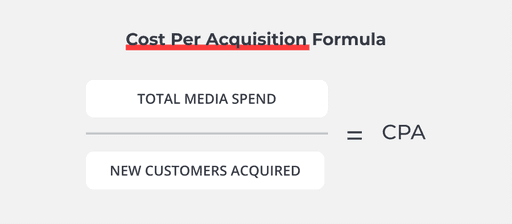



Average Deal Size
Average deal size represents the amount your customers spend per transaction. This is calculated by dividing your revenue generated over a specific time period by the number of transactions completed during that period.
Average Deal Size
Average deal size represents the amount your customers spend per transaction. This is calculated by dividing your revenue generated over a specific time period by the number of transactions completed during that period.
Average Deal Size
Average deal size represents the amount your customers spend per transaction. This is calculated by dividing your revenue generated over a specific time period by the number of transactions completed during that period.
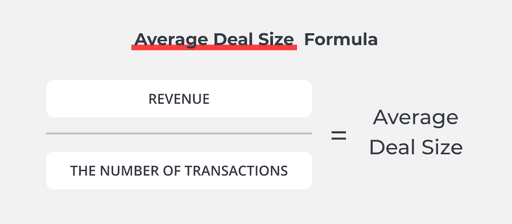



Sales Pipeline Value
Sales pipeline value is the estimated deal size for all the leads in your pipeline. To calculate, simply add up the estimated revenue your company would get for all the leads in your pipeline.
Sales Pipeline Value
Sales pipeline value is the estimated deal size for all the leads in your pipeline. To calculate, simply add up the estimated revenue your company would get for all the leads in your pipeline.
Sales Pipeline Value
Sales pipeline value is the estimated deal size for all the leads in your pipeline. To calculate, simply add up the estimated revenue your company would get for all the leads in your pipeline.




Cost Per Qualified Opportunities
Cost per (qualified) opportunity is similar to cost per acquisition mentioned above. However, rather than dividing the total media spend by the number of new leads acquired, you divide it by the number of opportunities for a given time period. If your Win or Close Rate is high and your CPO is low, you’re targeting the right audience with a product your sales team can sell.
Cost Per Qualified Opportunities
Cost per (qualified) opportunity is similar to cost per acquisition mentioned above. However, rather than dividing the total media spend by the number of new leads acquired, you divide it by the number of opportunities for a given time period. If your Win or Close Rate is high and your CPO is low, you’re targeting the right audience with a product your sales team can sell.
Cost Per Qualified Opportunities
Cost per (qualified) opportunity is similar to cost per acquisition mentioned above. However, rather than dividing the total media spend by the number of new leads acquired, you divide it by the number of opportunities for a given time period. If your Win or Close Rate is high and your CPO is low, you’re targeting the right audience with a product your sales team can sell.
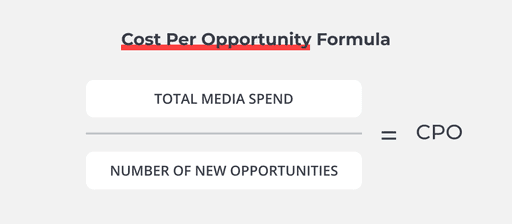



Revenue Generated Against Overall Marketing Budget
At the end of the fiscal year, you should be reviewing the revenue generated against the overall marketing budget. This is similar to CPA and CPL but for the overall marketing budget. It is a good indicator if your demand gen efforts are being impactful. To calculate, divide your revenue against your marketing budget.
Revenue Generated Against Overall Marketing Budget
At the end of the fiscal year, you should be reviewing the revenue generated against the overall marketing budget. This is similar to CPA and CPL but for the overall marketing budget. It is a good indicator if your demand gen efforts are being impactful. To calculate, divide your revenue against your marketing budget.
Revenue Generated Against Overall Marketing Budget
At the end of the fiscal year, you should be reviewing the revenue generated against the overall marketing budget. This is similar to CPA and CPL but for the overall marketing budget. It is a good indicator if your demand gen efforts are being impactful. To calculate, divide your revenue against your marketing budget.
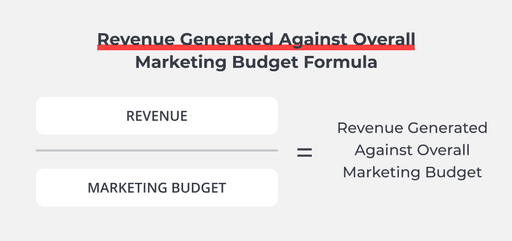



Close Rate
While generating Closed Won deals is your target, it’s equally important to understand your close win rate. An above average % here means not only is your sales team succeeding in closing and customers are easily finding the value in your offering. If this % is below average, then you’ll want to speak with your sales team to understand why - then work together on ways to shore is up in your marketing/messaging if possible.
Close Rate
While generating Closed Won deals is your target, it’s equally important to understand your close win rate. An above average % here means not only is your sales team succeeding in closing and customers are easily finding the value in your offering. If this % is below average, then you’ll want to speak with your sales team to understand why - then work together on ways to shore is up in your marketing/messaging if possible.
Close Rate
While generating Closed Won deals is your target, it’s equally important to understand your close win rate. An above average % here means not only is your sales team succeeding in closing and customers are easily finding the value in your offering. If this % is below average, then you’ll want to speak with your sales team to understand why - then work together on ways to shore is up in your marketing/messaging if possible.




Paid social grounded in demand gen will elevate your company’s growth
Creating demand for products and services is one of the toughest challenges for today’s B2B brands.
This is largely due to the outdated ways we have been taught that creating a B2B brand works.
Yes, once upon a time you could create a great piece of content, run an ad, offer a gated asset like an eBook and convert someone to a paying customer.
It was easy.
Unfortunately, as the internet has matured, so have consumers.
They no longer buy off a whim or appreciate when a salesperson calls them after submitting their information.
They like to spend time doing their due diligence; researching independently, speaking to their colleagues and getting recommendations from their peers in online communities.
The best today’s B2B brands can hope for is intentionally creating great content that meets their ideal customer wherever they are in their buying journey.
The goal is to nurture and remain top of mind so that by the time that customer is ready to buy, your sales team gets a high-quality, qualified lead.
Yes, this strategy takes time and patience but the result is so much better.
Just ask yourself what would you rather have.
100 low-quality leads that convert at less than 1% because you focused on generic lead generation?
A predictable pipeline that regularly sees better conversations between buyers and sellers which lead to better conversion rates and increased bottom-line revenue.
There are significant rewards waiting for you on the other side of adopting a demand generation mentality into your paid social strategy.
Paid social grounded in demand gen will elevate your company’s growth
Creating demand for products and services is one of the toughest challenges for today’s B2B brands.
This is largely due to the outdated ways we have been taught that creating a B2B brand works.
Yes, once upon a time you could create a great piece of content, run an ad, offer a gated asset like an eBook and convert someone to a paying customer.
It was easy.
Unfortunately, as the internet has matured, so have consumers.
They no longer buy off a whim or appreciate when a salesperson calls them after submitting their information.
They like to spend time doing their due diligence; researching independently, speaking to their colleagues and getting recommendations from their peers in online communities.
The best today’s B2B brands can hope for is intentionally creating great content that meets their ideal customer wherever they are in their buying journey.
The goal is to nurture and remain top of mind so that by the time that customer is ready to buy, your sales team gets a high-quality, qualified lead.
Yes, this strategy takes time and patience but the result is so much better.
Just ask yourself what would you rather have.
100 low-quality leads that convert at less than 1% because you focused on generic lead generation?
A predictable pipeline that regularly sees better conversations between buyers and sellers which lead to better conversion rates and increased bottom-line revenue.
There are significant rewards waiting for you on the other side of adopting a demand generation mentality into your paid social strategy.
Paid social grounded in demand gen will elevate your company’s growth
Creating demand for products and services is one of the toughest challenges for today’s B2B brands.
This is largely due to the outdated ways we have been taught that creating a B2B brand works.
Yes, once upon a time you could create a great piece of content, run an ad, offer a gated asset like an eBook and convert someone to a paying customer.
It was easy.
Unfortunately, as the internet has matured, so have consumers.
They no longer buy off a whim or appreciate when a salesperson calls them after submitting their information.
They like to spend time doing their due diligence; researching independently, speaking to their colleagues and getting recommendations from their peers in online communities.
The best today’s B2B brands can hope for is intentionally creating great content that meets their ideal customer wherever they are in their buying journey.
The goal is to nurture and remain top of mind so that by the time that customer is ready to buy, your sales team gets a high-quality, qualified lead.
Yes, this strategy takes time and patience but the result is so much better.
Just ask yourself what would you rather have.
100 low-quality leads that convert at less than 1% because you focused on generic lead generation?
A predictable pipeline that regularly sees better conversations between buyers and sellers which lead to better conversion rates and increased bottom-line revenue.
There are significant rewards waiting for you on the other side of adopting a demand generation mentality into your paid social strategy.
Find this article helpful?
Share with a friend.
Find this article helpful? Share with a friend.
Find this article helpful? Share with a friend.
Growth design tips to your inbox
© 2023
© 2023
© 2023
© 2023
© 2023